In discussing the 'selectivity' of perception I have alluded to foregrounding and backgrounding. We owe the concept of 'figure' and 'ground' in perception to the Gestalt psychologists: notably Max Wertheimer (1880-1943), Wolfgang Köhler (1887-1967) and Kurt Koffka (1886-1941). Confronted by a visual image, we seem to need to separate a dominant shape (a 'figure' with a definite contour) from what our current concerns relegate to 'background' (or 'ground'). An illustration of this is the famous ambiguous figure devised by the Danish psychologist Edgar Rubin.
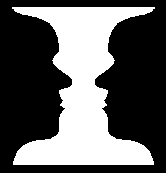
Images such as this are ambiguous concerning figure and ground. Is the figure a white vase (or goblet, or bird-bath) on a black background or silhouetted profiles on a white background? Perceptual set operates in such cases and we tend to favour one interpretation over the other (though altering the amount of black or white which is visible can create a bias towards one or the other). When we have identified a figure, the contours seem to belong to it, and it appears to be in front of the ground.
In addition to introducing the terms 'figure' and 'ground', the Gestalt psychologists outlined what seemed to be several fundamental and universal principles (sometimes even called 'laws') of perceptual organization. The main ones are as follows (some of the terms vary a little): proximity, similarity, good continuation, closure, smallness, surroundedness, symmetry and prägnanz.
The principle of proximity can be demonstrated thus:
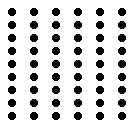
What you are likely to notice fairly quickly is that this is not just a square pattern of dots but rather is a series of columns of dots. The principle of proximity is that features which are close together are associated. Below is another example. Here we are likely to group the dots together in rows.
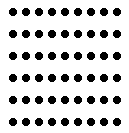
The principle also applies in the illustration below. We are more likely to associate the lines which are close together than those which are further apart. In this example we tend to see three pairs of lines which are fairly close together (and a lonely line on the far right) rather than three pairs of lines which are further apart (and a lonely line on the far left).

The significance of this principle on its own is likely to seem unclear initially; it is in their interaction that the principles become more apparent. So we will turn to a second major principle of perceptual organization - that of similarity. Look at the example below.
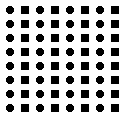
Here the little circles and squares are evenly spaced both horizontally and vertically so proximity does not come into play. However, we do tend to see alternating columns of circles and squares. This, the Gestalt psychologists would argue, is because of the principle of similarity - features which look similar are associated. Without the two different recurrent features we would see either rows or columns or both...

A third principle of perceptual organization is that of good continuity. This principle is that contours based on smooth continuity are preferred to abrupt changes of direction. Here, for instance, we are more likely to identify lines a-b and c-d crossing than to identify a-d and c-b or a-c and d-b as lines.

Closure is a fourth principle of perceptual organization: interpretations which produce 'closed' rather than 'open' figures are favoured.

Here we tend to see three broken rectangles (and a lonely shape on the far left) rather than three 'girder' profiles (and a lonely shape on the right). In this case the principle of closure cuts across the principle of proximity, since if we remove the bracket shapes, we return to an image used earlier to illustrate proximity...

A fifth principle of perceptual organization is that of smallness. Smaller areas tend to be seen as figures against a larger background. In the figure below we are more likely to see a black cross rather than a white cross within the circle because of this principle.
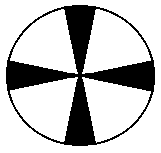
As an illustration of this Gestalt principle, Coren, Ward and Enns (1994, 377) argue that it is easier to see Rubin's vase when the area it occupies is smaller. The lower portion of the illustration below offers negative image versions in case this may play a part. To avoid implicating the surroundedness principle I have removed the conventional broad borders from the four versions. The Gestalt principle of smallness would suggest that it should be easier to see the vase rather than the faces in the two versions on the left below.
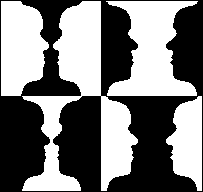
The principle of symmetry is that symmetrical areas tend to be seen as figures against asymmetrical backgrounds.

Then there is the principle of surroundedness, according to which areas which can be seen as surrounded by others tend to be perceived as figures.

Now we're in this frame of mind, interpreting the image shown above should not be too difficult. What tends to confuse observers initially is that they assume that the white area is the ground rather than the figure. If you couldn't before, you should now be able to discern the word 'TIE'.
All of these principles of perceptual organization serve the overarching principle of pragnänz, which is that the simplest and most stable interpretations are favoured.
What the Gestalt principles of perceptual organization suggest is that we may be predisposed towards interpreting ambiguous images in one way rather than another by universal principles. We may accept such a proposition at the same time as accepting that such predispositions may also be generated by other factors. Similarly, we may accept the Gestalt principles whilst at the same time regarding other aspects of perception as being learned and culturally variable rather than innate. The Gestalt principles can be seen as reinforcing the notion that the world is not simply and objectively 'out there' but is constructed in the process of perception.
-
Visual Perception 1: Searching for Patterns
-
Visual Perception 2: The Third Dimension
-
Visual Perception 3: Selectivity and Perceptual Constancy
-
Visual Perception 4: Cultural and Environmental Factors
-
Visual Perception 5: Individual Differences, Purposes and Needs
-
Visual Perception 6: Context and Expectations
-
Visual Perception 7: Gestalt Principles of Visual Organization
-
Visual Perception 8: The Moving Image
-
References and Suggested Reading

|